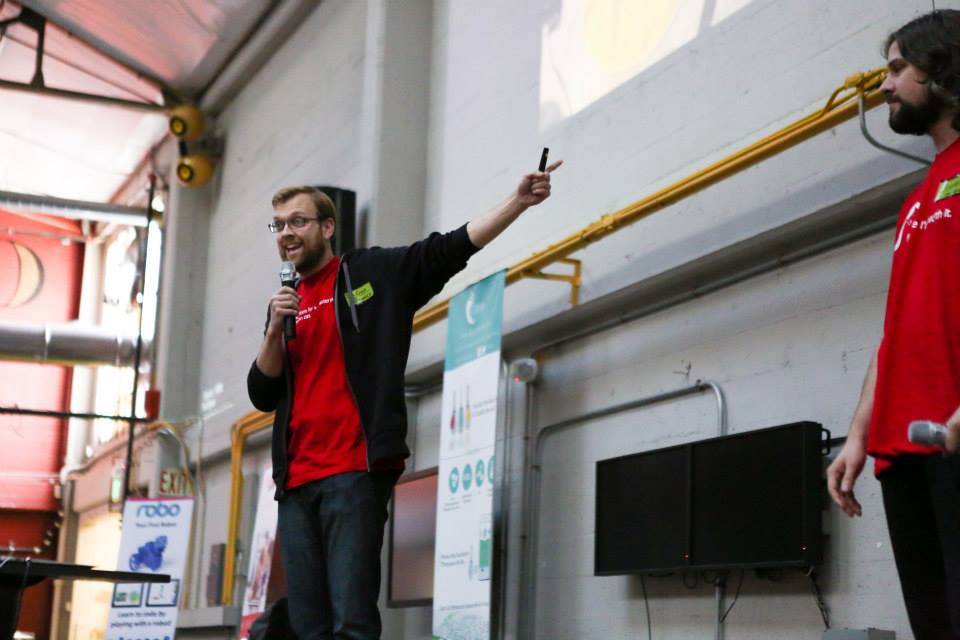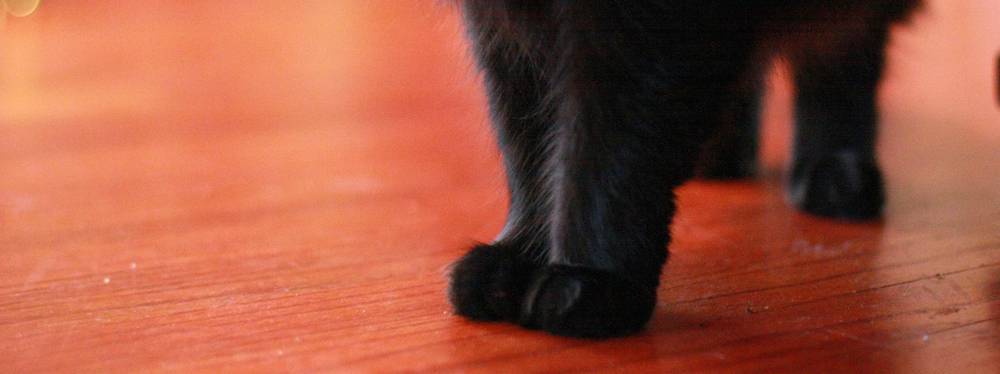U of I’s Research Park contains an office building called EnterpriseWorks, a medium-sized (43,000 square feet or nearly 4,000 square meters) incubator for startups and other entrepreneurial endeavors. Within this structure, on the second floor, you’ll find an unassuming door with a piece of paper taped to the inside of its safety glass window. That piece of paper has the adorable cat-eared logo and name of the company Petronics.
Smile Politely has written about the local startup before, and a lot has happened since that last article. Petronics, and their flagship product Mousr, have come a long way since the days of early alpha-testing and their successful Kickstarter campaign.
The Petronics office is sparsely outfitted. There are four industrial desks immediately visible: three for employees and one which supports the current prototype and its camera-bearing obstacle. From the exposed ductwork in the cavernous ceiling hang two U of I banners — one in blue and one in orange. There is a large printer (or something resembling one) a work sink, and a mini fridge. Odd file cabinets are tucked beside or near the desks. The surfaces are scattered with the expected detritus of a robotics company: bits and pieces of robots, scrap paper, pens, computers, and bills from the university. Above everything, filling the air, is the unignorable drone of the HVAC system.

Dave Cohen, photo from Petronics’ Facebook page
I met with two of Petronics’ team members, Dave Cohen and Michael “Doom” Friedman. Cohen is quiet, business-like, and very careful about his word choices (perhaps because I asked if I could record our conversation). Friedman is friendly, talkative, and soft-spoken in a way that seems to contradict the excitement he obviously feels about his work. It is clear, despite the cute logo, that the company deserves to be taken seriously.
Before interviewing the pair, I was lucky to have been able to see the latest prototype of Mousr at the recent Innovation Celebration and I was most impressed. Cat toys, it seems, are usually designed more for the entertainment of the owner than the cat. In my own experience, it is rare that my cat will play with anything for longer than a few minutes before becoming bored and completely ignoring it. Of designing Mousr, Cohen said, “The key is to do something that responds to the cat.” He mentioned as an example the difference between a laser that moved about autonomously but randomly and a human with a laser. “A cat will get bored with a randomly moving laser, and not because they can’t catch it. They stay interested when a human is playing with the laser because they want something that, when they chase it, it runs.” The idea of needing to intelligently design a cat toy flies in the face of many armchair cat psychologists who claim that a cat will play with absolutely anything. Maybe that’s true of kittens, but as cats get older, their kitten playfulness is replaced by an evolutionarily defined bloodlust which must be sated in one way or another.
It may be an exaggeration to claim that the minds at Petronics are some kind of feline Freuds, but not much of one. Michael alone has four cats, and all members of the team have spent years studying cat behavior. As part of research for the development of Mousr’s AI, they have even sought out and studied scholarly articles written by cat behavioralists. Though they wouldn’t say it themselves, they are probably experts in the field. They are able to explain even the most strange of cat behaviors.
For instance, have you ever noticed that a cat will sometimes completely ignore a toy that’s in the middle of the room, but will attack the same toy if it’s tossed inside of a box or around a corner? According to Friedman, that’s because a cat will ignore its prey (the toy) if it feels it can’t sneak up on it. “Cats want to hunt; they want to be predators,” he says. Anyone who has played with a cat has seen the instinct. The cat crouches, its tail tip flicking, its eyes focused — one ear on the target, the other listening for any out-of-place sound. It may creep forward, always keeping low and under cover, trying to get close enough to pounce. Though not every cat is good at it, the instinct is always there.
In its original concept, Mousr would have had on-board cameras to allow it to behave like prey and try to evade a cat’s attack. Partially for the sake of size (cats like to play with smaller things) and partially for the sake of more cat-enticing behavior, the camera has been moved to the aforementioned cardboard obstacle. Cohen said, “That lets us make the mouse smaller, faster, lighter, and flippable. All those things are very cat-driven.” He also explained how the change helped Mousr become a smarter robot. “It improves our field of view and it constrains the action to a play area, which helps us to avoid the issue of, ‘well, what if the mouse goes under a sofa or whatever?’” Another major benefit of this configuration (and one that I was lucky enough to be able to play with) is what Petronics is calling “hybrid mode”. In hybrid mode, a human can look at a mock-up of the playfield (from an overhead perspective) on a device (smart phone, tablet, etc.) and tap or click somewhere on the screen. Mousr will then decide the best path to get to that location, even navigating around known obstacles, and will execute the command as quickly as possible. This method of playing is considered to be a “hybrid” of the best that humans and the Mousr AI have to offer. With Mousr doing the driving, the human can focus on what kind of movement their cat would be most interested in.
This iteration of Mousr also has a tail which can be swapped out for different materials — “some cats like crinkly stuff, some cats like feathers,” as Friedman explains — or a speaker. The speaker will allow Mousr to emit startled chirps when it is pounced upon and to squeak in terror when it is caught or thrown about by a cat. That kind of cause-and-effect play keeps cats engaged and increases their interest over time. Cats are basically sadists in fur suits (a lot like some of my friends in undergrad). Friedman sums it up well: “For whatever reason, cats feed off of fear. They love it when something is afraid of them.”
Still, Mousr may leave some observers nonplussed. Sure, anyone with the resources and the time can make a robot that does many of the things Mousr does, but that would be missing the point. “What makes Mousr really novel in an academic sense,” Friedman said, “is that what it does, it does really fast. And it’s relatively cheap for what it is.”
Ever the scientists, Petronics hopes to be able to use the device to further understand the world of cats and their mental states. “One of the things we want to do,” Cohen said, “is use data gathered from Mousr to define different archetypes of cats. We want to be able to say, ‘these are the different types of cats, and if your cat is one of these couple of types, it will enjoy these types of toys.’ We want to be very honest with our findings. We want people to feel confident before they spend money on a fancy cat toy.” They are already planning follow-up questionnaires that will be sent to their first customers to provide further insight into how cats play with Mousr.

As information about how cats play with Mousr comes in, Petronics can update the behavior of Mousr accordingly. Using an on-board Bluetooth receiver, a customer will be able to update the firmware on Mousr and the obstacle’s camera unit wirelessly, ensuring that Mousr is always up-to-date and operating in the most cat-pleasing way.
Yes, Petronics wants to improve Mousr and eventually turn it into the ultimate cat toy, but they’re not growing sated by any means. They already have their minds on something beyond Mousr.
Both Cohen and Friedman agree that it would be amazing to design kids’ toys. In their experiments with Mousr, they found that sometimes children enjoyed playing with the robot as much as cats did. They’d like to use their hard-earned resources to create educational robotics toys that could do for children what Mousr should do for cats. “If we were able to design toys for kids, we’d focus much more on toys that would inspire their creativity as opposed to just being a game,” Cohen elaborated. “Those toys are the ones with longevity. If you get a game, you beat it, and you’re done. If you get something that makes you think and makes you use your creativity, it’ll stick with you and it will always be fun.” They admitted that if they were able to venture into designing children’s toys, the company’s name would probably have to change at least a little.

In addition to the quandary of how to design a device or toy with the ability to remain relevant in the market and in the hearts of either children or pets, there is the enigma which is manufacturing in China. Some of the employees of Petronics spent time living in China and making the proper connections, opening doors, and getting their collective foot wedged firmly in. Assuredly, this experience (funded at least partly by the HAXLR8R program) will make it easier for them to bring their next product to market more efficiently.
Speaking of which, I had to ask: how is Mousr’s timeline looking? The Mousr Kickstarter was funded successfully on December 5th of 2014. “We’re looking to get manufacturing after Chinese New Year,” I was told. Chinese New Year is a significant date because the manufacturing center in China where Mousr will be produced almost completely shuts down for the holiday. Still, significant progress is being made. The team at Petronics has been working with industrial designers to “give Mousr a look that matches his high energy” and with lawyers to ensure they can patent the device in both the United States and China to protect their intellectual property. Hopefully, actual manufacturing will begin sometime in February or shortly thereafter. After that would come managing the packaging and shipping of the product to the Kickstarter backers, followed by the other pre-order customers. The hope, the desire, is to have Mousr ready for consumers by the late fall, just in time for the holiday shopping season.
I mentioned that talk of marketing was conspicuously absent when discussing the product. Apparently, it’s not a concern at all. “People have told us they’ve found us because they’ve Google Searched ‘robot mouse’ and we’re the only company,” Michael says with his perpetual smile. “People wanted this product and we are providing it,” Cohen continues. “We get about three email sign-ups a day with absolutely no marketing. And no product, there’s just a little teaser video.” You can’t argue with three unsolicited contacts a day.
Unfortunately, if you are now interested in pre-ordering a Mousr, you’re out of luck. Though the Petronics website has a pre-order button, the button will take you to a sign-up form for their email list. Don’t be too disappointed, though; you’ll be able to pre-order or order very soon, so if you’re interested, it’s definitely worth it to sign up for their email list. They promise not to bother you with anything not worth reading, and you can promise not to read anything not worth writing. So, if you’ve been scratching your head trying to find the perfect gift for your lovely feline friend, sign up for the email list, sit back, relax, and look forward to the robotic mouse of your cat’s dreams.








